Your performance on the server side / back end plays a vital part in the efficiency of your website. Here are a few possible reasons why it might be slow.
Overview The page velocity consists of parts on both the front-end and the server side. GTmetrix evaluates your page's front-end structure to guarantee that it is supplied to your visitors as optimally as possible, but an optimized server-side is also an significant component of the equation in providing a quick and seamless web experience.
Test your site now!
It's simple to put too much emphasis on the front-end with Page Speed and YSlow and forget about the server-side. It is essential to remember that although you may have elevated ratings for PageSpeed and YSlow, by optimizing your server side, you could create your website even quicker.
When a page application is produced, both Front-end and Server-side parts take some time to finish their activities. Because their operations are essentially sequential, the total page load time can be considered as their cumulative time.
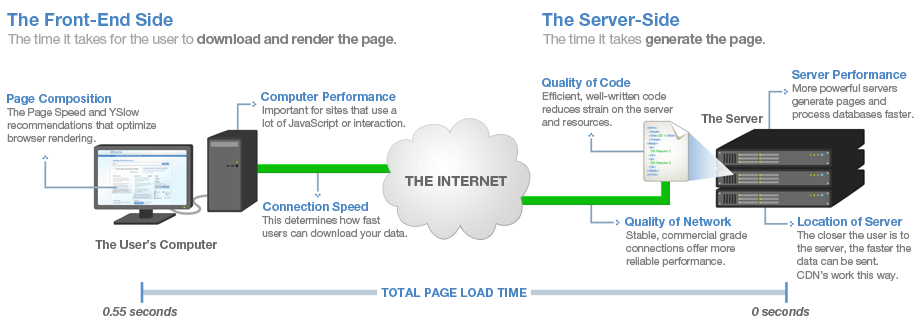 The front and back-end factors to site speed: A fast time is composed of both of these sides working in an optimal setup.
The front and back-end factors to site speed: A fast time is composed of both of these sides working in an optimal setup.
Even after you’ve optimized your Front-end, speed gains can still be achieved by optimizing the Server-side. This means optimizing the way the page is generated by your server.
A good indicator of your Server-side performance is the time it takes to generate the HTML page (page generation time). This is labeled as “Waiting” time on the first element in the waterfall graph (also known as the “time to first byte”). Generally, this time should be kept under one second (or as low as possible).
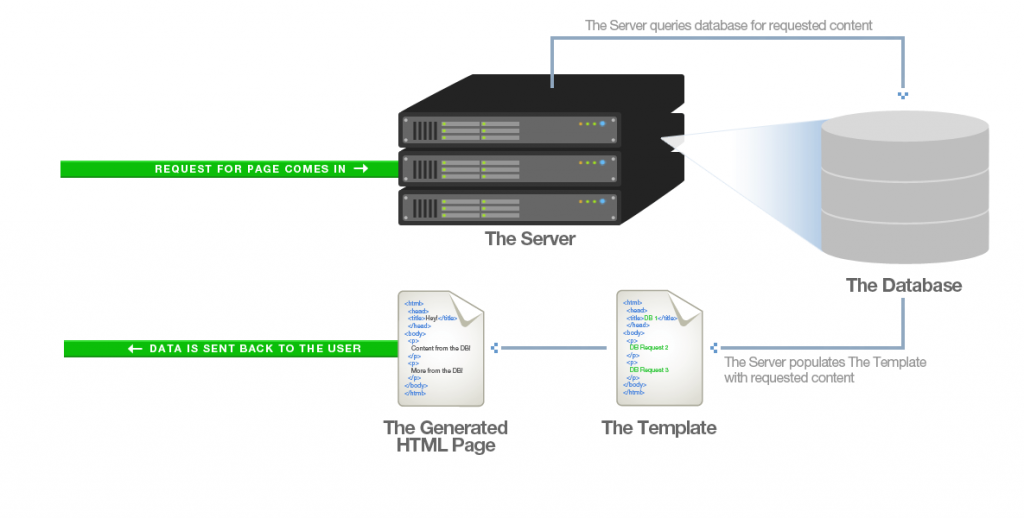 The server gets a request, queries the database for content, builds the page, and sends generated html back.
The server gets a request, queries the database for content, builds the page, and sends generated html back.
Since the server is handling thousands of requests for the same page, and is essentially “building” the same page every time, why not build the page once, and send that “pre-built” version to anybody that requests it? This is referred to as page caching. With Page Caching
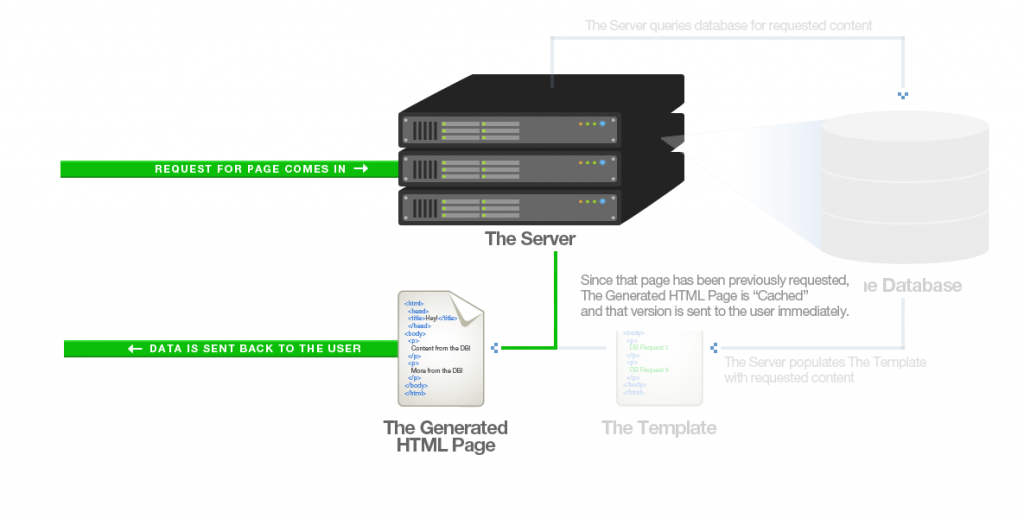 If the server receives a page application it created earlier, it instantly returns that version. It's the "Cached" variant.
If the server receives a page application it created earlier, it instantly returns that version. It's the "Cached" variant.
It is like providing them photocopies of a flyer to send your customers cached versions of websites. Each moment someone asks for one, it is much quicker for you to offer them picturing than redrawing and writing the material.
Page caching can be a very effective means of speeding up the generation of a page, but it also has its downsides:
Pages that require authentication can’t be cached (as they often contain user information on them).
Changes to pages don’t show up until the page cache has expired.
More Powerful Servers
Let’s define two popular terms in the hosting world:
Shared or Virtual Hosting: Including your website, there are many websites on the server. The processing power and resources of each website are shared.
Hosting dedicated: You're the only server user. The processing capacity and resources of the server are exclusively devoted to your website.
The Issues With Shared Hosting
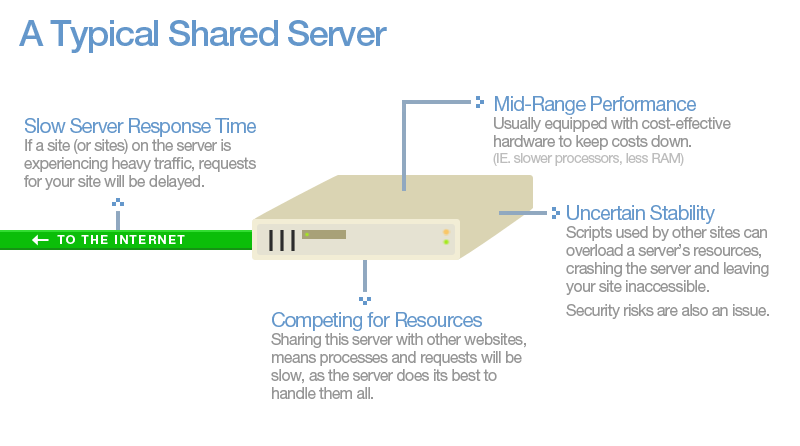 A shared server often is underpowered and oversubscribed.
A shared server often is underpowered and oversubscribed.
Shared hosting is the most affordable, and can be reliably used for starter sites or development purposes.
However, when an enterprise level site matures to the point where traffic is ramping up, a shared server cannot offer much in terms of speed enhancements.
How Dedicated Hosting Compares
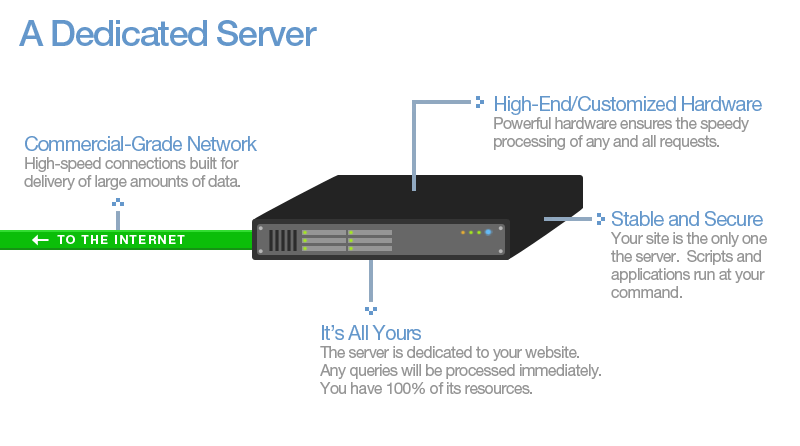 A Dedicated server.
A Dedicated server.
Larger sites may require multiple dedicated servers (clusters) that play different roles (database querying, media serving, etc.) to generate a faster page load. These servers are built for performance, and so their specifications are quite powerful.
Dedicated servers are typically reserved for higher-traffic, resource intensive websites (you won’t need one for a small website about your cat) and are higher in cost than shared servers. They are a must, however, for enterprise-level websites and businesses where their website is mission-critical.
Results
By combining your server-side efficiency with a quick front end, you can achieve great outcomes for the loading moment of your website. In general it can take less than 0.5 seconds to generate the page on complicated dynamic locations.
Overview The page velocity consists of parts on both the front-end and the server side. GTmetrix evaluates your page's front-end structure to guarantee that it is supplied to your visitors as optimally as possible, but an optimized server-side is also an significant component of the equation in providing a quick and seamless web experience.
Test your site now!
It's simple to put too much emphasis on the front-end with Page Speed and YSlow and forget about the server-side. It is essential to remember that although you may have elevated ratings for PageSpeed and YSlow, by optimizing your server side, you could create your website even quicker.
What's loading my page time?
When a page application is produced, both Front-end and Server-side parts take some time to finish their activities. Because their operations are essentially sequential, the total page load time can be considered as their cumulative time.

Even after you’ve optimized your Front-end, speed gains can still be achieved by optimizing the Server-side. This means optimizing the way the page is generated by your server.
A good indicator of your Server-side performance is the time it takes to generate the HTML page (page generation time). This is labeled as “Waiting” time on the first element in the waterfall graph (also known as the “time to first byte”). Generally, this time should be kept under one second (or as low as possible).
How Can I Make the Server-side Faster?
A slow server side has many causes, but they can fundamentally be divided into two classifications:
Inefficient code or SQL
Bottlenecks/Slow Server
As each site has a distinctive platform and installation, each site is responsible for resolving these problems. One site may need an optimized server code, but another site may only need a more strong server. Budget limitations can also be involved because server-side code optimization can be inexpensive for small speed gains rather than server upgrading for huge speed gains.
Before you take a server-side option path, it is best to really understand your needs.
Solutions:
The following optimizations are commonly used to improve server-side speed:
Code Optimization
Programming languages like PHP, Perl, Python, or ASP are usually teamed up with databases like MySQL, PostgreSQL, or Microsoft SQL Server to create software such as WordPress, Drupal, Magento and all sorts of custom platforms.
This software is usually fairly optimized out of the box, but there are often many customization to the code or plugins that cause slow performance as a result of inefficient code or UN-optimized database queries.
Code optimization includes analysis of queries in code and databases and the location of inefficient code and slow database queries. It is the task of a developer to correct these issues after discovering these "hot spots." For code, this usually includes a better algorithm or changing the code to operate around a bottleneck (i.e.. This can include adding indexes to databases to speed up the request, rewriting the request or changing the database structure.
Page Caching
Most websites today are dynamic, meaning that they pull from a database of information, insert the pulled data into templates, and then serve them to you. This happens every time somebody requests a page from the server, and the time it takes to perform this process is dependent on the efficiency of the code and the power of said servers.
Without Page Caching
Inefficient code or SQL
Bottlenecks/Slow Server
As each site has a distinctive platform and installation, each site is responsible for resolving these problems. One site may need an optimized server code, but another site may only need a more strong server. Budget limitations can also be involved because server-side code optimization can be inexpensive for small speed gains rather than server upgrading for huge speed gains.
Before you take a server-side option path, it is best to really understand your needs.
Solutions:
The following optimizations are commonly used to improve server-side speed:
Code Optimization
Programming languages like PHP, Perl, Python, or ASP are usually teamed up with databases like MySQL, PostgreSQL, or Microsoft SQL Server to create software such as WordPress, Drupal, Magento and all sorts of custom platforms.
This software is usually fairly optimized out of the box, but there are often many customization to the code or plugins that cause slow performance as a result of inefficient code or UN-optimized database queries.
Code optimization includes analysis of queries in code and databases and the location of inefficient code and slow database queries. It is the task of a developer to correct these issues after discovering these "hot spots." For code, this usually includes a better algorithm or changing the code to operate around a bottleneck (i.e.. This can include adding indexes to databases to speed up the request, rewriting the request or changing the database structure.
Page Caching
Most websites today are dynamic, meaning that they pull from a database of information, insert the pulled data into templates, and then serve them to you. This happens every time somebody requests a page from the server, and the time it takes to perform this process is dependent on the efficiency of the code and the power of said servers.
Without Page Caching

Since the server is handling thousands of requests for the same page, and is essentially “building” the same page every time, why not build the page once, and send that “pre-built” version to anybody that requests it? This is referred to as page caching. With Page Caching

It is like providing them photocopies of a flyer to send your customers cached versions of websites. Each moment someone asks for one, it is much quicker for you to offer them picturing than redrawing and writing the material.
Page caching can be a very effective means of speeding up the generation of a page, but it also has its downsides:
Pages that require authentication can’t be cached (as they often contain user information on them).
Changes to pages don’t show up until the page cache has expired.
More Powerful Servers
Let’s define two popular terms in the hosting world:
Shared or Virtual Hosting: Including your website, there are many websites on the server. The processing power and resources of each website are shared.
Hosting dedicated: You're the only server user. The processing capacity and resources of the server are exclusively devoted to your website.
The Issues With Shared Hosting

Shared hosting is the most affordable, and can be reliably used for starter sites or development purposes.
However, when an enterprise level site matures to the point where traffic is ramping up, a shared server cannot offer much in terms of speed enhancements.
How Dedicated Hosting Compares

Larger sites may require multiple dedicated servers (clusters) that play different roles (database querying, media serving, etc.) to generate a faster page load. These servers are built for performance, and so their specifications are quite powerful.
Dedicated servers are typically reserved for higher-traffic, resource intensive websites (you won’t need one for a small website about your cat) and are higher in cost than shared servers. They are a must, however, for enterprise-level websites and businesses where their website is mission-critical.
Results
By combining your server-side efficiency with a quick front end, you can achieve great outcomes for the loading moment of your website. In general it can take less than 0.5 seconds to generate the page on complicated dynamic locations.
0 Response to "Why is my page slow by googleadsensesafetips44"
Post a Comment
WELCOME to https://www.googleadsensesafetips44.tk/.